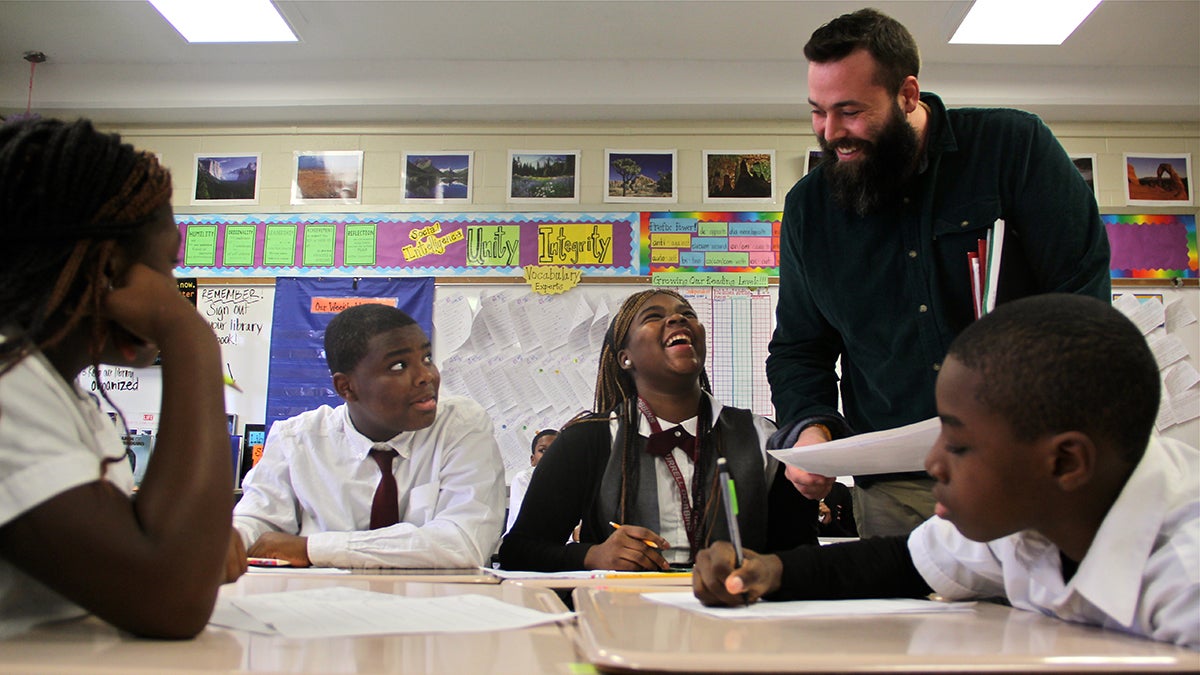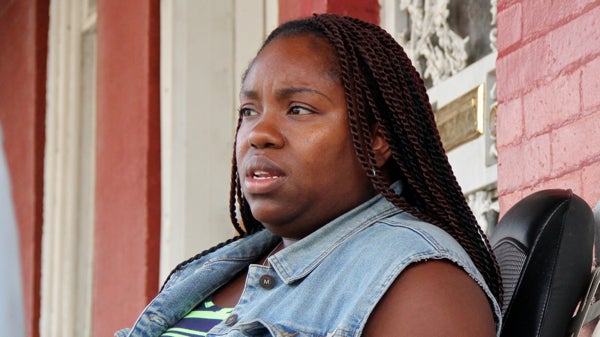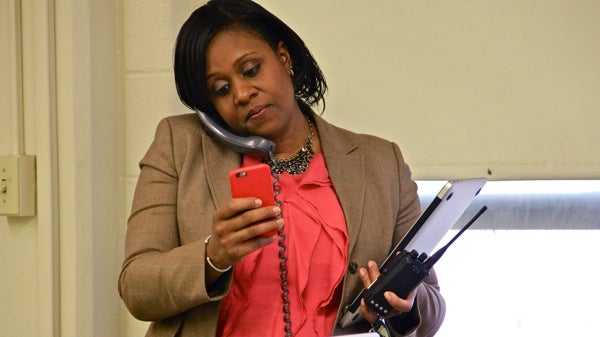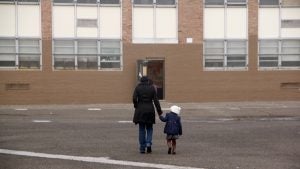Part One: The Big Shakeup
In 2014, a group of passionate faculty members took a big gamble to improve Blaine Elementary. Would it work?
Listen 10:32
Teacher Andrew Brooking works with students at Blaine Elementary School. (Emma Lee/WHYY)
Maureen Brower faced a choice.
It was March 2014. She’d been teaching at Blaine Elementary School in North Philadelphia’s Strawberry Mansion neighborhood for five years.
For the first couple of years, she thought she could see her students’ lives improving as a direct result of her work. Then she began to notice that kids she had taught just a few years before seemed to be adrift. That’s when the doubts first started coming.
“It would make me upset, because I felt like all the work that I had done was now undone, and I didn’t know how to fix it,” she said. “And I wanted to fix it.”
Brower often took her frustrations home, venting them to her husband, sometimes in tears.
“My kids that I’ve had, are not my kids anymore. I don’t know where they went. I don’t know what happened to them, and I need to fix them and I don’t know how.”

Part of the problem, Brower thought, came from a lack of cohesion among the faculty.
“In previous years we haven’t always had 100 percent of teachers following through,” she said. “They were just kinda set in their ways of just doing the same thing over and over again.”
The school’s principal, Gianeen Powell, had become increasingly frustrated with this as well.
“You just have to have the right people on board who want to do the same type of work — not come in at a certain time and leave at a certain time,” Powell said. “This is hard work, and hard work takes a lot of time outside of the school day.”
Late in the 2013-14 school year, Powell began pushing to make a big change.
With the school district’s consent, aided by a private, philanthropic grant, Blaine Elementary had been working on a plan to reimagine the school. Through that process, Powell hoped to exercise a clause in the teacher’s contract that allows half of a school’s faculty to be pushed out for a school turnaround effort.
But she didn’t want to do it unless there was support among the school’s teacher leaders, including Brower.
Brower and the leadership team mulled it over. Eventually, they voted yes and then helped Powell interview new applicants for their former colleagues’ jobs.
“Seeing my most successful students not be so successful anymore, that made me want to make a change, need to make a change, for the kids and community to become better,” said Brower.
That vote happened in the March of 2014, and soon after, all teachers had to reapply for their jobs.
The teachers union cried foul, and some of the faculty complained of being left in the dark.

In April 2014, principal Powell said, “I did sit-down one-on-ones with each one of the teachers, and they were able to say if they wanted to be here. Some of them said, ‘No, this is a great opportunity for me to take my years and go to another school.’”
A new slate of teachers was hired with the promise that the shakeup would vastly improve student achievement.
Since then, for more than a year, through dozens of interviews with parents, students, teachers and staff, NewsWorks has tracked Blaine’s attempt at transformation, and found that the stakes for this work are immense.
Children, parents, grandparents have hopes and dreams hanging in the balance. Educators devote themselves wholly to the cause, often sacrificing their personal lives.
And at bottom, there’s a question that is of utmost importance to the city of Philadelphia: Can the school district vastly revitalize a neighborhood school in one of the most poverty-stricken neighborhoods in the city in the midst of an ongoing budget crisis.
‘That’s the neighborhood.’
A school like Blaine, does not — cannot — simply teach reading, writing, math and science. Situated in the heart of Strawberry Mansion, the K-8 school absorbs the problems that plague the surrounding community.
Blaine parent Roslinda Harris knows the issues as well as anybody.

“When you turn the TV on, what do you see and what do you hear? Someone gunned down in Strawberry Mansion area on such and such street.”
During the day, the thunder of motorbikes ripping through the streets roars through Harris’ narrow row home. At night, gun shots aren’t a surprise.
“It never fails. If you look at the statistics of the neighborhood and you were a teacher or a staff member in that school, you wake up, you listening to that everyday, you’re about to come to a war zone,” she said.
The predominantly African-American school sits in a neighborhood where the median household income is about $20,000. About a quarter of the adults in the neighborhood don’t have a high school diploma. One in four students has a special-education disability.
When kids come to Blaine, they’re often years below grade level in reading and math, and many arrive weighed down by social, emotional and behavioral impediments to learning.
And what’s clear to anyone who’s spent time there — turnaround or not — the school still lacks basic supports to even begin to address the children’s needs.
“Our needs in this school are so high, like, kids, the stories you get, the families you get, parent-teacher conferences. One day I had five or six parents bawling in the conferences, crying because they want their students to do so well,” said math teacher Andrew Brooking. “But they’re dealing with so many challenges outside of school that get in the way of them being able to really effect change in their own kid’s life. And that’s the neighborhood.”
The school district did not give Blaine any special budgetary treatment. So, like many elementary schools in the city in the past few years, Blaine doesn’t have a full-time nurse, guidance counselor, or school police officer, which often leaves those tasks to Principal Powell.
“I am like the CEO of a school instead of the instructional leader, because I am the nurse. I am the counselor part time,” said Powell. “I’m filling in for all the things that are missing within the school.”
In the face of such vast problems and systemic deficiencies, the whole idea of “turnaround” can seem Sisyphean. But this past year brought differences that many say have made an important impact.
“They painted inside. They fixed it up real nice. It’s gorgeous inside,” said parent Cynthia Thomas, who has two young children at the school.
It’s these outward, physical differences that tend to catch the eye on first glance. New paint job. New school logo. More technology in the classroom. College banners hanging above every door.
For parent Andrea Garrett it’s the school’s new student uniform policy: sharp white oxford shirts and burgundy sweaters.
“It’s teaching them how to dress different, not just jeans and t-shirts. It’s teaching them how to be responsible and how to be in the world,” she said. “You know when they go to work and apply for jobs, you gotta dress a certain way.”

But there are other important changes too.
The school day is an hour longer four days of the week, allowing students to be released early on Wednesdays so that staff can regularly meet for professional development and collaboration.
Student data is now regularly tracked, shared with parents in real time, and discussed among faculty.
Principal Powell thinks of the school as a kind of laboratory, where teachers are in constant, open dialogue about how to improve classroom instruction.
“And it’s not like, you know, a put down. It’s like, ‘No, we’re identifying a concern, and we are addressing that concern, and then we’re practicing. So practice making perfect and then going into that classroom ready to go.”
Openness itself has become a mantra. Parents are free to come into the school whenever they wish, and classroom doors are not to be closed.
“They have to open their doors, and anybody can walk in, and they can give feedback to each other openly and not be fearful to ask questions or say, ‘I don’t know.’”
‘More complicated than I thought’
Much of Blaine’s turnaround effort was made possible by a $1.5 million grant from the Philadelphia School Partnership. That’s the money that gave the school a facelift, paid for a turnaround consultant, sent Powell to a year-long, intensive principal training program, and sent school leaders on tours of other successful school turnarounds across the country.
The grant came to the school in large part because of the organization’s faith in Principal Powell, who’s now going into her eighth year at the helm at Blaine, an eternity for a Philly neighborhood school principal.

“My personal life, I don’t have one,” said Powell. “I’m a single mom, two kids. I have a 6-year-old and a 12-year-old. They know whenever I come home we’re sitting at the table. We’re doing homework, and Mommy’s doing work too. They know this is very important. They come here on their days off and sit in the classrooms.”
In the first few years especially, the work of changing school culture and rapidly improving student ability is gruelling and frustrating.
It takes educators who are willing to devote an almost unhealthy amount of time to a job where hurdles are high, setbacks are often, and progress can seem like a mirage.
In a school like Blaine, one of the most useful skills for educators is learning how to roll with the punches.
After one of our interviews midway through the year, Principal Powell was on her way to a classroom to observe a teacher when a young student was escorted into the main office by a school bus attendant.
Unbeknownst to anyone at Blaine, the attendant said the child was transferring in from another nearby district school — a not-at-all-rare occurrence. Dealing with these sort of on-the-fly changes only complicates the already Herculean task of school turnaround.
But this is the nitty-gritty of the work in Philadelphia’s neighborhood schools, where systemic gaps and institutional failings can only be bridged by educators, like Andrew Brooking, who are willing to stretch themselves thin.
“If I’m going to do something, I want to do it right. What drives that? It’s a passion, deep down,” said Brooking, who has been doing intense, school turnaround work for the last six years.
“I don’t think I’d want a job where I just go home, five-o’clock, shut the light off and I’m done. So I think that’s just a personality thing.”

“If I’m going to do something, I want to do it right. What drives that? It’s a passion, deep down.”
Brooking is one of the new teachers at Blaine, one who came in after the big shakeup. He’s big-bearded with deep brown eyes — evoking visions of a Beat poet at the blackboard.
In his early twenties he left upstate New York to help underserved communities in Mexico, Chile, and California. In 2010, he zagged back across the country in a U-Haul to teach in Philadelphia.
Before Blaine, he taught at one of KIPP’s Philadelphia charter schools. There he says he learned to be a relentlessly effective educator. At Blaine, he has a partner teacher, also newly arrived from KIPP, which only accepts students through a lottery.
“She and I know, lived and saw what it means to create a super-effective classroom, kids that are growing three years in one year,” he said. “We know what that looks like, feels like and sounds like in a way. I know that it’s possible. So why not go back to a place where you don’t have to be lucky to be there?”
Following Brooking through Blaine’s year of turnaround revealed the highs and lows of the work. It also raised questions about its sustainability.
Brooking comes to Blaine at 6 a.m. every day, and doesn’t leave until 6 p.m. In that time he prepares lessons, writes curriculum, teaches, coaches other teachers, gives extra help to kids, and works with parents.
His own personal life takes a backseat to the kids at Blaine. At age 31, he has no designs on marriage or a family.
“It’s almost like a birth control just working with kids here all the time,” he said. “I don’t have any desire to have children at this point, because I feel like I have 30 of them right now.”
When we talked in August 2014, during the first week of school, he was upbeat, confident and excited.
By December, it was a different story.
“Ahhh, last time we talked. August, wow,” he said with a sigh. “It’s like a whirlwind, I feel like. You know?”
After months of living and breathing the challenges, Brooking looked tired.
“I think going every day with high expectations can wear you down a little bit, can be challenging. And so we’re going through the work right now,” he said. “Is it sustainable? I don’t know. I think, for me, I personally don’t see myself teaching 10 years from now.”
People without much direct experience in schools often say they can’t understand why great progress can’t be made quickly in underperforming schools.
The conversation then turns into a debate: One side questions the adequacy of resource levels, and the other questions the effectiveness or dedication of educators.
During the last school year, Blaine had a lot of what modern education reformers seek: A trusted school leader working with a teaching force handpicked to carry out her vision.
Still, interview after interview led back to one word: money.
“Before I worked in a school, I didn’t realize that everyone can work their absolute hardest and, if you’re not getting all the funding you need, that you’re just still going to be suffering,” said Cynthia Jones, who came to the school this past year through AmeriCorps to coordinate community outreach.
“I kinda just thought, ‘If everybody tries their best, I’m sure it could work out.’ But it’s a lot more complicated than I thought it was,” she said.
As the school year progressed, Brooking found himself himself in an existential struggle. He came to Blaine thinking he’d stay only as long as he thought that the work being done through the turnaround was making a substantial difference.
By the mid-point in the year, he constantly questioned the school’s progress. Among the faculty, his skepticism increased.
“So I’ll talk to my other leadership members, and they’ll be like, ‘You should have seen last year,’” he said. “And I’m like, ‘So?’ I’m like thinking, ‘We need to keep pushing. This is not good enough.’
“And I think that’s been the consistent thing in my head, ‘We are not there. We are not close.’”
WHYY is your source for fact-based, in-depth journalism and information. As a nonprofit organization, we rely on financial support from readers like you. Please give today.




